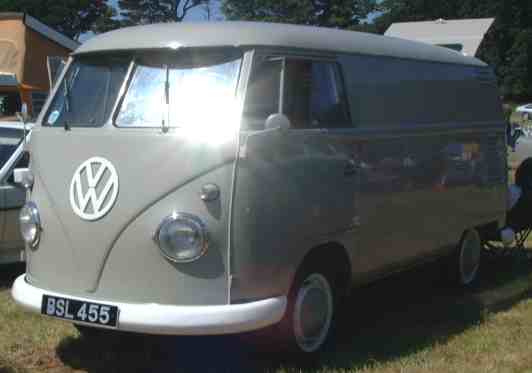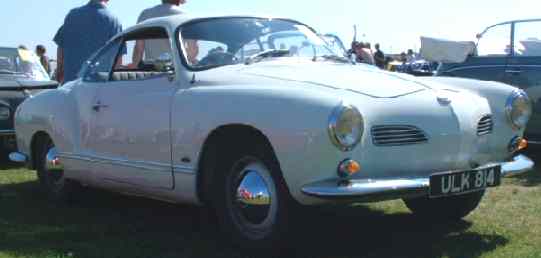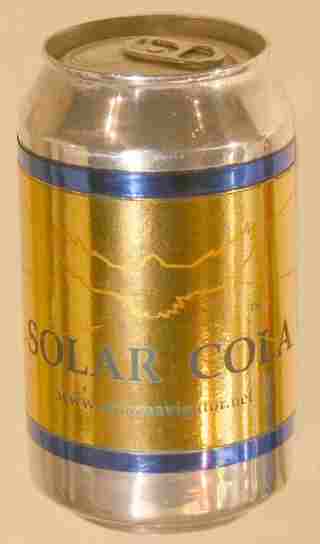|
VOLKSWAGEN
BEETLE LINKS
The
Volkswagen Beetle Car originated in Germany and is produced by the company
Volkswagen. In German, Volkswagen means: People's Car. This Beetle
has outsold every sort of car that has ever been made. It dates back to
the early thirties and its history still grows as it continues to be
produced. Production has now spanned over sixty five years and new
technologies have been implemented along the way. Some of these are shown
in the timetable below.

Split
screen VW van
How
The Beetle Began: In the early 1930's, Ferdinand Porsche and his
company Dr.-Ing. h.c. Ferdinand Porsche GmbH designed a prototype of the
Beetle Car. It was a streamlined sedan with a rear engine so that the
driveshaft would be shorter, whilst the weight of the engine would still
be distributed safely. This prototype was built by a motorcycle producer
called Zundapp and test driven in 1932. It did not go into production
though because Zundapp decided to keep making motorcycles as they were in
high demand.
It
is a little known fact that Professor Porsche worked with electric
vehicles in the early 1900's. Porsche used a wheel motor in the hubs
to propel his vehicles and later when working with the Lohner company,
they produced four wheel drive electric vehicles. Later still
Professor Porsche worked with Mercedes on an electric hybrid vehicle,
where a petrol engine drove a generator which powered the electric
traction motors of the "Mercedes Mixt."
Adolf
Hitler at this time had a vision of his countrymen being able to own a
cheap car and had plans on creating great networks of roads called
autobahns. Hitler invited Porsche to submit to him a design for this
peoples car, it had to be cheap, economical, fast (all of 60 miles per
hour) and to accommodate two adults and three children comfortably. So, in
January 1934 Porsche gave Hitler a proposal for his car and by June that
year work had begun. Some funding was given by the RDA (Reichsverband der
Autmobilindustrie - the German Auto Dealers Association), to help pay the
bills!
The
three 1936 prototypes didn't even have rear windows but this soon changed.
By 1937 30 prototypes had come out of the factory and were tested for
faults. In May 1938 Hitler laid the foundation stone of the Volkswagen
Beetle GmbH factory at Fallersleben, near Hanover and he also had a town
called Kraft durch Freude Stadt (this name comes from Hitlers motto
"Joy through Strength") built for the factory workers. Hitler
also decided that this new car of the people was also to be known as the
KdF-wagen, (short for the "Joy through Strength" car).
Finally,
in April 1939 production started on the KdF-wagen but only 210 were made
before World War 2 (1939-1945) disrupted the Western World and bombing
ruined the factory. During the War production ceased but by 1946, the
1000th Beetle Car had rolled out of the factory and the town of KdF had
been renamed to Wolfsburg after Werner von Schulenberg of Wolfsburg who
had been forced to give up his land for the building of the town and
factory. This was a much simpler car than those we jump into today. Cars
produced during 1946-1948 had a rear window with a split down the middle,
so it was really two windows and indicators popped out from a space
between the front and back doors. There was a rear brake light that looked
suspiciously like a nose and the petrol tank was hidden under the hood -
there wasn't even a petrol gauge, but there was a speedomoter!
From
1945-1947 the British Military ran the factory before handing it back to
Germany in 1948. By the end of that year nearly a quarter of the Beetles
produced were exported, mainly to Europe. This was just the beginning for
the Beetle Car's international trip to fame.

Karman
Ghia - based on Beetle floorpan & engine
The
Life Story of Professor Dr. "Ferry" Porsche
Although
the company of Dr. Ing. h.c.F Porsche AG was formed on April 25, 1931 as
"designers and consultants for land, sea and air vehicles," it
was Professor Dr. Ferry Porsche, son of the automotive genius Professor
Ferdinand Porsche, who steered the company into becoming one of the
world's leading automotive engineering design companies and specialist
manufacturer of sports cars. From the time he designed the first Porsche,
the Type 356 in 1948, it was his personal involvement that made Porsche
the great marque it is today.
When
Ferdinand Anton Ernst Porsche, known as "Ferry," was born in
Wiener Neustadt, Austria, on September 19, 1909, his father was Technical
Director of the Austro-Daimler Company. Never far away from the
automotive work of his father, Ferry Porsche was soon behind the wheel of
a car and, by the age of twelve, was even permitted to run in the class
winning Targo Florio car, the lightweight Austro-Daimler Sascha.
When
the Porsche family moved to Stuttgart in 1923 for Professor Ferdinand
Porsche to become the Technical Director of Daimler-Benz, the south German
automotive center became Ferry Porsche's second home. It is there that he
was educated and met his wife, Dorothea, she remained his staunch
companion until her death in 1985, and was the mother of his four sons.
Ferry
Porsche started working with his father when the latter formed his
independent design office. Their first contract, designated number 007 to
give the impression it was not their first project, was a 2-liter car for
Wanderer. The success of this car was later to lead the newly founded Auto
Union Company, which had incorporated Wanderer, to appoint Professor
Porsche as the designer of a new Grand Prix car to meet the new 750 kgs.
maximum weight formula.
The
Auto Union was the most advanced pre-war racing car design concept. It was
of lightweight construction, featured a 16-cylinder super-charged engine,
with unique valve control mounted just behind the driver; an engine
position which is standard for all modern generation F1 cars. Ferry
Porsche played no small part in its design and construction. Less well
known is the fact Ferry Porsche conducted much of the initial test driving
of the car until his father declared one day, "I have enough drivers,
but only one son."
One
other car which the Porsche firm designed before World War II was to have
an important influence on both Ferry Porsche and the rest of the world. It
was, of course, the most produced car of all time: the Volkswagen Beetle.
The war itself cut deep into the life of the young automobile designer.
Transferred from demolished Stuttgart to the Carinthian town of Gmund in
1943, Ferry Porsche and a few colleagues had to start again from scratch
in 1945 by keeping busy with repair jobs and the construction of simple
farm machinery.
Meanwhile,
the French held Ferry's father, Professor Ferdinand Porsche until 1947,
when Ferry Porsche's family managed to raise sufficient money from new
contracts in Italy to buy his freedom. One of these design projects
resulted in the Cisitalia Formula 1 race car, unveiled at the Turin Motor
Show that same year. It was the first race car with a midmounted engine
and four-wheel drive.
After
that, Ferry Porsche decided to build his own sports car, effectively the
first "Porsche." He took out plans he made back in 1939 for a
light, compact car based on the Volkswagen, practically the only
components available in Germany at the time. Besides providing speedy
acceleration, unmatched braking and good road holding, an essential
criterion was the car had to be practical for everyday use. Its
"marketing concept" adopted by Ferry Porsche was, "If I
build a car that gives me satisfaction, then there must be others with the
same sort of dreams who would be prepared to buy such a car."
The
first car to bear the Porsche name, the Type 356, was delivered on June 8,
1948. It boasted a tubular space frame chassis, an aluminum body and a
rear-mounted four-cylinder 1.131 cc VW engine. The following year, in
order to ensure continued production of the 356, Ferry Porsche negotiated
a new contract with the then head of Volkswagen, Heinz Nordoff, for the
supply of parts. Besides this, the contract appointed Dr. Ing h.c.F
Porsche K.G. as consultant engineer to VW, sole importer of VW's for
Austria and recipient of a royalty sum on every VW Beetle produced at
Wolfsburg.
A
total of fifty-two 356 cars were built at Gmund in Austria before the
company returned to Stuttgart. Production recommenced there in March 1950.
During the same year, Porsche began designing its own engine, the Carrera.
The 356 model, which was initially forecast to have a world sales
potential of 500 units, was last produced in 1965 after over 78,000 cars
had been built. The policy of model longevity is continued today with the
Porsche 911, which enters its 35th year of production.
Professor
Dr. Ferry Porsche was happy and grateful that his father witnessed with
approval, shortly before he died on January 30, 1951, the start of Porsche
as a specialist sports car manufacturer. Since 1948, decades of hard,
dedicated work were put in by him to further enhance the Porsche product,
which enjoyed a fine reputation from the beginning, by expanding customer
service and marketing, not to mention accelerating product development
through motor racing.
Since
entering Le Mans in 1951 and achieving a class win, the name Porsche has
been synonymous with success in motor sport. Amongst its numerous
triumphs, Porsche has been crowned World Endurance Champion in sports car
racing 14 times and, since 1970, has won the Le Mans 24-hour race a record
15 times. The world famous Monte Carlo rally was won four times by Porsche
911s, and an experimental 4WD 911 Carrera won the 1984 Paris-Dakar desert
race first time out, the very first sports car ever to achieve this honor.
Subsequently in 1986, Porsche 959s finished first, second and sixth on
their debut outing in the event as well as becoming the first all-wheel
drive racing car to enter and win its class at Le Mans.
In
all, Professor Dr. Ferry Porsche demanded a great deal from his engineers,
mechanics and drivers. He made courageous investments in new developments
and thereby founded the worldwide reputation of his firm as a privately
controlled, independent producer of technologically advanced sports and
racing cars for worldwide use.
In
1972, the year the Porsche family withdrew from active management of the
company, Weissach was opened. Today, Weissach is world famous as a site
for research and development, where 30%, of all work is undertaken on
behalf of other manufacturers, governments and NATO.
Back
in 1965, Ferry Porsche was awarded an Honorary Doctorate by the Technical
University of Vienna in recognition of his achievements in so many
branches of the automobile world. In 1984 on his 75th birthday he was
awarded the honorary title of 'Professor.'
BIOGRAPHICAL
NOTES: PROFESSOR DR. ING. H.C.F PORSCHE - (1909-1998)
1909
Ferdinand Porsche was born in Wiener Neustadt, Austria on September 19.
1931
Began his activities as a designer in the engineering consultancy of his
father, Dr. Ing h.c.F Porsche KG.
1932
Ferdinand Porsche's duties expanded to include supervision and
coordination of testing. Assisted with the design and development of the
Auto Union race car.
1934
Head of VW Testing
1935
Ferdinand Porsche became the Manager of the Research Department in the
newly established Porsche test plant, Stuttgart-Zuffenhausen.
1935
Married Dorothea Reitz from Stuttgart (died 1985). They had four sons.
1938
Head of Development Department. In same year the design studio moved to a
newly built building in Stuttgart-Zuffenhausen.
1940
Took over the post of deputy director for the entire operation.
1945
Ferdinand Porsche headed the firm, moved to Gmund in Carinthian during the
war, and initiated development of the legendary Porsche 356, based on the
Volkswagen and the first car to carry the Porsche name.
1948
The first 356 was completed in June.
1949
After completing the first 52 cars of this 356 range, Ferdinand Porsche
with his company and most of his colleagues returned to Stuttgart-Zuffenhausen.
Rebuilding of the consultancy offices for outside contracts took place.
1950
Production of the Porsche 356 began in Stuttgart-Zuffenhausen.
1959
Professor Theodor Heuss presented the Grosse Verdiensstkreuz (Commander's
Cross of the Order of Merit) of the Federal Republic of Germany to
Ferdinand Porsche in September.
1965
The Technical University of Vienna honored Ferdinand Porsche in November
with the presentation of the title, Dr. techn. E.h.
1972
The Dr. Ing. h.c.F Porsche KG became a joint stock company (AG). Dr.
Ferdinand Porsche assumed the post of Chairman of the Supervisory Board.
1975
Dr. Porsche received the Grosse Goldene Ehrenzeichen (Great Golden Cross
Of The Order Of The Order Of The Order Of the Order of Merit) of the
Republic of Austria in Vienna on January 31.
1979
On September 19, Lothar Spath, Prime Minister of Baden-Wurttemberg
presented Dr. Porsche with the Grosse Verdienstkreuz mit Stern (Knight
Commander's Cross) of the Bundesverdienstorden, on the occasion of his
70th birthday.
1984
A third of the entire Dr. Ing. h.c.F Porsche AG capital was offered to the
public in the form of non-voting preference shares on April 25.
On
September 19, Dr. Ferry Porsche celebrated his 75th anniversary and was
awarded the honorary title of 'Professor.'
1985
The Guild of Motoring Writers Vice Presidents trophy for outstanding
achievements in the field of automobilism was won by Professor Dr.
Ferdinand Porsche. Honor of "Senator E.h." by University of
Stuttgart.
1990-
1998 Honorary President of Supervisory Board, Porsche AG.
Please
click on the links above to find out about these famous automotive makers.
If your company is not included and you would like to be listed, please
let us know.
Automotive
Prehistory Links

Solar
Cola sponsor this website
|